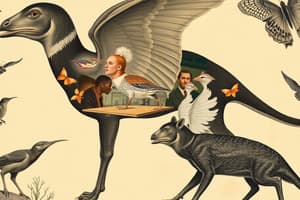Podcast
Questions and Answers
Animals reproduce only sexually.
Animals reproduce only sexually.
False (B)
Wildlife conservation efforts focus primarily on protecting animals in captivity.
Wildlife conservation efforts focus primarily on protecting animals in captivity.
False (B)
Domesticated animals are used only for food purposes.
Domesticated animals are used only for food purposes.
False (B)
Zoonoses can only be transmitted from humans to animals.
Zoonoses can only be transmitted from humans to animals.
All unicellular organisms have a nucleus.
All unicellular organisms have a nucleus.
Animals have developed diverse behaviors such as social structures, communication systems, and mating rituals.
Animals have developed diverse behaviors such as social structures, communication systems, and mating rituals.
Humans have not caused habitat destruction through deforestation, urbanization, and pollution.
Humans have not caused habitat destruction through deforestation, urbanization, and pollution.
Climate change does not pose a significant threat to wildlife.
Climate change does not pose a significant threat to wildlife.
Conservation organizations do not work to protect endangered species and their habitats.
Conservation organizations do not work to protect endangered species and their habitats.
Understanding animal adaptations, behaviors, and threats is not crucial for promoting sustainable practices.
Understanding animal adaptations, behaviors, and threats is not crucial for promoting sustainable practices.
Flashcards are hidden until you start studying
Study Notes
Animals
Introduction
Animals are a diverse group of organisms that share several common traits. They are multicellular, eukaryotic, and motile, and they obtain their energy from food. They can be found in nearly every environment on Earth, from the polar ice caps to the depths of the ocean. In this article, we will discuss various aspects of animals, including their classification, behaviors, and relationships with humans.
Classification of Animals
The classification of animals is based on their physical characteristics and evolutionary relationships. The Linnaean system, developed by Carl Linnaeus in the 18th century, is the most widely used system for classifying animals. It divides animals into five major groups:
- Protista: These are unicellular or multicellular organisms that do not fit into the plant, animal, or fungi kingdoms. Examples include paramecium and euglena.
- Fungi: These organisms obtain their nutrients by decomposing organic matter or by forming symbiotic relationships with other organisms. Examples include mushrooms and yeast.
- Plants: These organisms synthesize their own food through photosynthesis. Examples include trees, flowers, and grasses.
- Animalia: This is the largest kingdom, which includes all multicellular, eukaryotic, motile organisms. Animals are divided into several phyla, including:
- Protostomia: Including insects, spiders, and mollusks.
- Deuterostomia: Including vertebrates and echinoderms.
- Prokarya: These are unicellular organisms that do not have a nucleus or other membrane-bound organelles. Examples include bacteria and archaea.
Animal Behaviors
Animals exhibit a wide range of behaviors, which are essential for their survival and reproduction. Some common behaviors include:
- Feeding: Animals obtain food by consuming other organisms or by breaking down organic matter.
- Reproduction: Animals reproduce sexually or asexually, depending on the species.
- Defense: Animals have various mechanisms to protect themselves from predators, such as camouflage, venom, or aggressive behavior.
- Communication: Animals use a variety of signals, such as sound, scent, or color, to communicate with each other.
- Migratory: Some animals migrate to different habitats each year in search of food or breeding grounds.
Relationships between Humans and Animals
Humans and animals have been interacting for thousands of years, with various levels of cooperation and conflict. Some notable aspects of this relationship include:
- Domestication: Humans have domesticated many species of animals for their use as food, clothing, transportation, or companionship. Examples include dogs, cats, cows, and chickens.
- Wildlife Conservation: Many organizations work to protect endangered species and their habitats through education, research, and advocacy efforts.
- Animal Rights Activism: Some individuals advocate for animal rights and the ethical treatment of all creatures, including those used for food, clothing, or experimental purposes.
- Zoonoses: Humans can contract diseases from animals, such as COVID-19, which spreads between humans and animals through close contact with an infected host.
Conclusion
Animals play a vital role in maintaining the balance of ecosystems on Earth. By understanding their behaviors and relationships with humans, we can better appreciate these complex organisms and make informed decisions about how to coexist peacefully. As our knowledge of animals continues to grow, so does our ability to conserve their populations and promote sustainable interactions between human societies and wildlife communities.
Studying That Suits You
Use AI to generate personalized quizzes and flashcards to suit your learning preferences.




